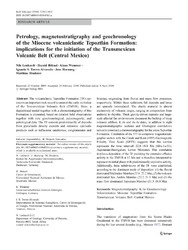Petrology, magnetostratigraphy and geochronology of the Miocene volcaniclastic Tepoztlán Formation: implications for the initiation of the Transmexican Volcanic Belt (Central Mexico)
Lenhardt, Nils
Böhnel, Harald
Torres-Alvarado, Ignacio
Hinderer, Matthias
72, 7: 817 - 832
DOI: https://doi.org/10.1007/s00445-010-0361-z
Persistent URL: http://resolver.sub.uni-goettingen.de/purl?gldocs-11858/6966
Persistent URL: http://resolver.sub.uni-goettingen.de/purl?gldocs-11858/6966
Lenhardt, Nils; Böhnel, Harald; Wemmer, Klaus; Torres-Alvarado, Ignacio; Hornung, Jens; Hinderer, Matthias, 2010: Petrology, magnetostratigraphy and geochronology of the Miocene volcaniclastic Tepoztlán Formation: implications for the initiation of the Transmexican Volcanic Belt (Central Mexico). In: Bulletin of Volcanology, Band 72, 7: 817 - 832, DOI: 10.1007/s00445-010-0361-z.
 |
Dokument öffnen: |
The volcaniclastic Tepoztlán Formation (TF) represents an important rock record to unravel the early evolution of the Transmexican Volcanic Belt (TMVB). Here, a depositional model together with a chronostratigraphy of this Formation is presented, based on detailed field observations together with new geochronological, paleomagnetic, and petrological data. The TF consists predominantly of deposits from pyroclastic density currents and extensive epiclastic products such as tuffaceous sandstones, conglomerates and breccias, originating from fluvial and mass flow processes, respectively. Within these sediments fall deposits and lavas are sparsely intercalated. The clastic material is almost exclusively of volcanic origin, ranging in composition from andesite to rhyolite. Thick gravity-driven deposits and large-scale alluvial fan environments document the buildup of steep volcanic edifices. K-Ar and Ar-Ar dates, in addition to eight magnetostratigraphic sections and lithological correlations served to construct a chronostratigraphy for the entire Tepoztlán Formation. Correlation of the 577 m composite magnetostratigraphic section with the Cande and Kent (1995) Geomagnetic Polarity Time Scale (GPTS) suggests that this section represents the time intervall 22.8–18.8 Ma (6Bn.1n-5Er; Aquitanian-Burdigalian, Lower Miocene). This correlation implies a deposition of the TF predating the extensive effusive activity in the TMVB at 12 Ma and is therefore interpreted to represent its initial phase with predominantly explosive activity. Additionally, three subdivisions of the TF were established, according to the dominant mode of deposition: (1) the fluvial dominated Malinalco Member (22.8–22.2 Ma), (2) the volcanic dominated San Andrés Member (22.2–21.3 Ma) and (3) the mass flow dominated Tepozteco Member (21.3–18.8 Ma).
Statistik:
ZugriffsstatistikSammlung:
- Geologie [931]

